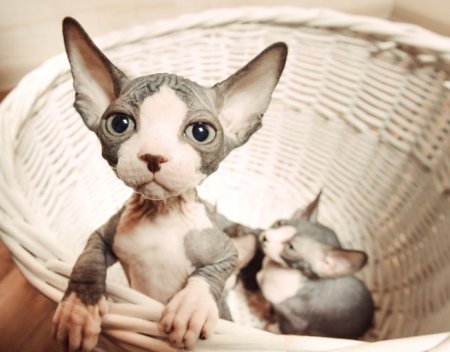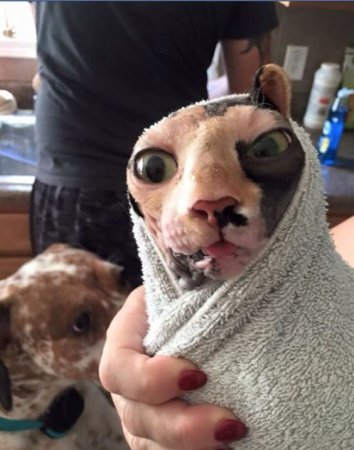How to Care for Sphynx Cats
Sphynx Cat Care
If you have a Sphynx, be prepared to groom it at least once a week. "What?" You say, "But it's hairless, why does it need grooming?" In fact, Sphynxes groom themselves as often as regular cats, but since they don't have enough fur to absorb the oil secreted by their skin or their saliva, grooming leaves a sticky, sometimes crusty residue of oil, sweat, and spit on their skin. Think of them in the same way you would think of a baby. It's hairless, close to the ground, not designed to clean itself, and has special needs.
Caring For Your Sphynx Cat’s Health
Toilet Habits
- don't cover their poop in the kitty litter
- their poop smells like the worst thing you have ever smelled and now you have visitors at the door
- they have trodden on their soft poop and cuddled up to you in front of the guests, leaving poopy marks all over you
- let an eyewatering fart go when you are cuddling them in front of the guests and explaining how gorgeous they are as a breed
If you cannot even contemplate being able to do those things then do not buy a Sphynx.
Feed your Sphynx cat often. The Sphynx cat lacks the insulating fur of other cat breeds, and therefore loses body heat more easily. The breed has a very high metabolism, which means your Sphynx cat needs to eat more than another cat might. You should always have dry food down for your cat to eat if you feed your cat dry food. If you feed your cat canned food, feed him three times a day or as needed to keep him satisfied.
If feeding your cat wet, canned food, try for an average of eight to 12 ounces of food per day.
You do not want your cat to be overweight, but your Sphynx cat should never be bony. If his weight decreases, or his ribs become more obvious, then increase the ration by five to 10%. Reweigh him again a week later to check the weight loss has been arrested.
Alternatively, look for a food that is marketed for active cats, or look for a breed-specific food made for Sphynx cats. These tend to be higher calorie than the equivalent amount of regular food.
Feed your Sphynx cat a good quality, protein rich food. Meat should be listed first and second on the pet food label. Avoid foods where a large percentage is cereal based.
Set up a litter box. You should provide your cat with a large litter box. It should be placed in a quiet, out of the way spot. Check with the breeder to see which cat litter he used to provide consistency for your cat.
Provide scratch posts. These provide an outlet for the cat's natural desire to scratch. Place several posts in your home, near entrance and exits, and next to the cat's bed.
Keep your Sphynx cat warm. Because of the small amount of hair, the Sphynx cat needs to be kept warm. Usually, keeping the cat in your home at room temperature is enough. Sphynx cats also often lie in sunlight shining through windows or sit near objects that give off heat. Your Sphynx may want to cuddle with you often to be near your body heat. He may also want to sleep beneath your comforter at night.
Provide access to blankets that your cat can lay on or under.
During the winter you may need to place your Sphynx cat in sweaters.
Protect your cat from sun exposure. Because the Sphynx cat’s skin is exposed, you need to protect it from the sun. A limited amount of sun is fine, but too much can give your cat sunburn.
Use UV blocking shirts or hats on your cat.
You may want to install sun-blocking screens on your windows to make sure your cat doesn’t lie in a sunny spot and get sunburnt.
Grooming Your Sphynx Cat
Bathing
A Sphynx cat needs a bath at least once a week, and preferably in a medicated pet shampoo like Malaseb to ensure any bacteria or other nasties are killed during the bath. Most cats of this breed have been acclimated to regular baths by their breeder, which you can see in all the cat videos of hairless kitties happily playing in the bath. However, sometimes a Sphynx will retain its cat instincts and really dislike getting wet. Make sure your breeder has worked at acclimatising your kitten to a regular bath, and continue regular bathing to reinforce the habit. Special rewards during and after will help.
Even with the bathing, your new friend may leave marks on furniture, sheets and your fluffy white towels just out of the drier if they sleep there for any length of time. This is because of their oily sweat glands, which can cause reddish brown oil to build up on their skin. Regular bathing will help, but it will not keep the cats from sweating, so if you cannot deal with the occasional oily brown sweat stain, this may not be the cat for you.
Wash your cat’s ears. Because of the large size of the Sphynx’s ears, they need to be cleaned regularly. Gently clean the ears with cleaning solution on a cotton ball or cotton swab once a week. If you neglect your Sphynx’s ears, he can get a build up of ear wax, oil, and dirt.
Clean your cat’s eyes. Sphynx cats don’t have eyelashes. This means that the eyes can get dirt and other build up around them, which can cause irritation. To clean your cat’s eyes, gently wipe them with a damp tissue.
- Don’t use anything containing alcohol or other irritants, like baby wipes, around your cat’s eyes. It will cause more irritation.
Nail Clipping
If you choose to trim your cat's nails, do so directly after its bath when the nails will be softer and easier to cut. Make sure to only trim the sharp ends and not the more sensitive pink part of the claws (called the "quick"). You can trim nails with any sharp nail clipper, and make sure to clean your cat's toes in the bath, as residue can sometimes build up!
Keeping Your Cat Happy
Give your Sphynx a lot of attention. Sphynx cats love people and being around people. If you want a cat to bond with who wants to take part in what you're doing, then a Sphynx is a good choice. Sphynx cats are known to follow their owners around the house with wagging tails.
Satisfy the Sphynx’s natural curiosity. The Sphynx is renowned for his inquisitive nature. He puts a lot of enthusiasm into whatever he does, which along with his natural curiosity means the Sphynx can get up to mischief if he’s not provided with an outlet for his normal behavior. Because of this energy and curiosity, the breed has a lot of character and can be seen as quite mischievous.
House your Sphynx cat inside. Because of your Sphynx cat’s lack of hair, you need to keep her inside. If she is left outside, she can get sunburned or too cold. If you let your Sphynx cat outside, make sure to watch her closely to make sure the elements don’t make her sick.
Consider companions for your Sphynx cat. The Sphynx cat is a social cat who doesn’t like being alone. If you are gone from home often, consider having another Sphynx cat or other pets. Sphynx cats do very well with other pets, including dogs and other cats.
Provide places for the cat to climb. Sphynx cats have a lot of energy. They like to climb on furniture and doors, and even climb on people’s shoulders. They also are good at balancing and can be acrobatic tricks. Make your home a fun place for your Sphynx cat to explore by giving him plenty of places to climb.
Consider attaching shelving to the wall in such a way that the cat has an aerial walkway around a room. Providing a high perch beside a door will give the Sphynx a great spot from which to watch people come and go, which could prevent your Sphynx trying to dash out the door each time.
Getting Your Cat Proper Vet Care
Vaccinate your cat. You should vaccinate your Sphynx cat against common infectious diseases, such as cat flu, feline infectious enteritis, feline leukemia, and rabies. The initial kitten vaccinations require two doses to be effective, given from nine weeks of age and given three to four weeks apart.
If in doubt about when to vaccinate, phone your local veterinary clinic to be advised of the protocol that they recommend and work to.
Get your cat booster injections once a year.
Desex your cat. Your Sphynx cat should be spayed or neutered. This generally takes place around five to six months old, before your female cat can start getting pregnant.
While you are getting your cat fixed, you can also have an identichip fitted. ID chips are a permanent way of identifying your cat.
Control parasites and worms. Other preventative health care for your cat includes parasite control and deworming. You want to discuss a flea prevention medicine with your vet. You should also get your cat dewormed every three months.



